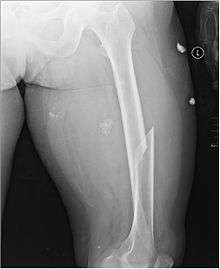Femoral fracture
| Femoral fracture | |
|---|---|
| Classification and external resources | |
| ICD-10 | S72 |
| AO | 31-A1 - 33-C3 |
| MeSH | 68005264 |
A femoral fracture is a bone fracture that involves the femur. They are typically sustained in high-impact trauma, such as car crashes, due to the large amount of force needed to break the bone.
Femoral shaft fractures

Femoral shaft fractures can be classified with the Winquist and Hansen classification, which is based on the amount of comminution:[1]
The fracture may be classed as open, which occurs when the bone fragments protrude through the skin, or there is an overlying wound which penetrates to the bone. These types of fracture cause more damage to the surrounding tissue, are less likely to heal properly, and are at much greater risk of infection.
Distal femur fractures
Fractures of the inferior or distal femur may be complicated by separation of the condyles, resulting in misalignment of the articular surfaces of the knee joint, or by hemorrhage from the large popliteal artery that runs directly on the posterior surface of the bone. This fracture compromises the blood supply to the leg (an occurrence that should always be considered in knee fractures or dislocations).[2]
Treatment
A 2015 Cochrane review found that available evidence for treatment options of distal femur fractures is insufficient to inform clinical practice and that there is a priority for a high-quality trial to be undertaken.[3]
Available evidence suggests that treatment depends on the part of the femur that is fractured. Traction may be useful for femoral shaft fractures because it counteracts the force of the muscle pulling the two separated parts together, and thus may decrease bleeding and pain.[4] Traction should not be used in femoral neck fractures or when there is any other trauma to the leg or pelvis.[5][6]
In femoral shaft fractures, reduction and intramedullary nailing is currently recommended. The bone is re-aligned, then a metal rod is placed into the femoral bone marrow, and secured with nails at either end. External fixators can be used to prevent further damage to the leg until the patient is stable enough for surgery. Open fractures must undergo urgent surgery to clean and repair them, but closed fractures can be maintained until the patient is stable and ready for surgery.[7] After surgery, the patient should be offered physiotherapy and try to walk as soon as possible, and then every day after that to maximise their chances of a good recovery. These fractures can take at least 4–6 months to heal.[8] EXOGEN is an ultrasound therapy can be used for non-union fractures which haven't healed for 9 months. There is good evidence that there are high rates of fracture healing and it reduces the number of patients that require surgery.[9]
References
- ↑ Page 612 in: Title Surgical treatment of orthopaedic trauma. Authors: James P. Stannard, Andrew H. Schmidt, Philip J. Kregor. Publisher: Thieme, 2007. ISBN 1-58890-307-9, ISBN 978-1-58890-307-5
- ↑ Keith L. Moore, Arthur F. Dalley, Anne M.R. Agur. p527 of Clinical Oriented Anatomy 7th edition ISBN 978-1-4511-8447-1
- ↑ Griffin, XL; Parsons, N; Zbaeda, MM; McArthur, J (13 August 2015). "Interventions for treating fractures of the distal femur in adults.". The Cochrane database of systematic reviews. 8: CD010606. PMID 26270891. doi:10.1002/14651858.CD010606.pub2.
- ↑ Tintinalli, Judith E. (2010). Emergency Medicine: A Comprehensive Study Guide (Emergency Medicine (Tintinalli)). New York: McGraw-Hill Companies. p. 9. ISBN 0-07-148480-9.
- ↑ AAOS. "29". In Andrew N. Pollak MD. FAAOS. Emergency Care and Transport of the Sick and Injured (Print) (10 ed.). Sudbury, Massachusetts: Jones and Bartlett. pp. 1025–1031. ISBN 978-1-4496-3056-0.
- ↑ Marx, John A. (2014). Rosen's emergency medicine : concepts and clinical practice (Eighth edition. ed.). London: Elsevier Health Sciences. p. 680. ISBN 9781455749874.
- ↑ "Femur Shaft Fractures (Broken Thighbone)-OrthoInfo - AAOS". orthoinfo.aaos.org. Retrieved 2016-12-14.
- ↑ "Femoral Fractures. Information about Femur fractures. Patient | Patient". Patient. Retrieved 2016-12-14.
- ↑ "EXOGEN ultrasound bone healing system for long bone fractures with non-union or delayed healing | Guidance and guidelines | NICE". www.nice.org.uk. Retrieved 2016-12-14.